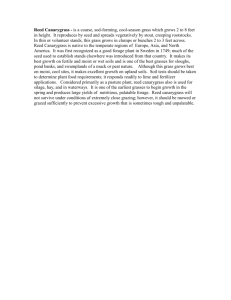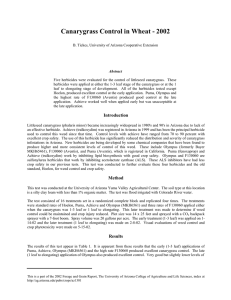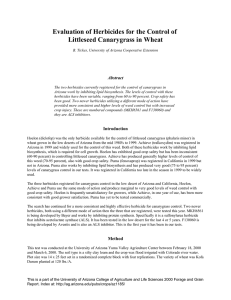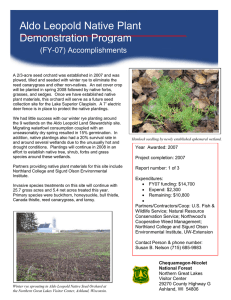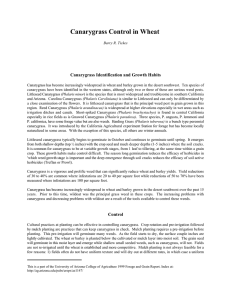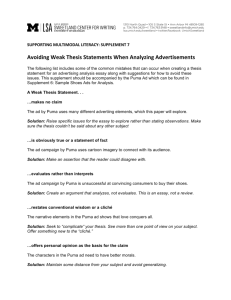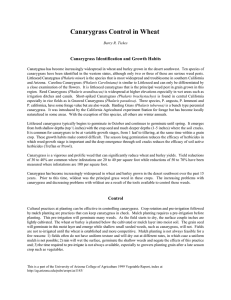Canarygrass Control in Wheat - 2003 Abstract
advertisement
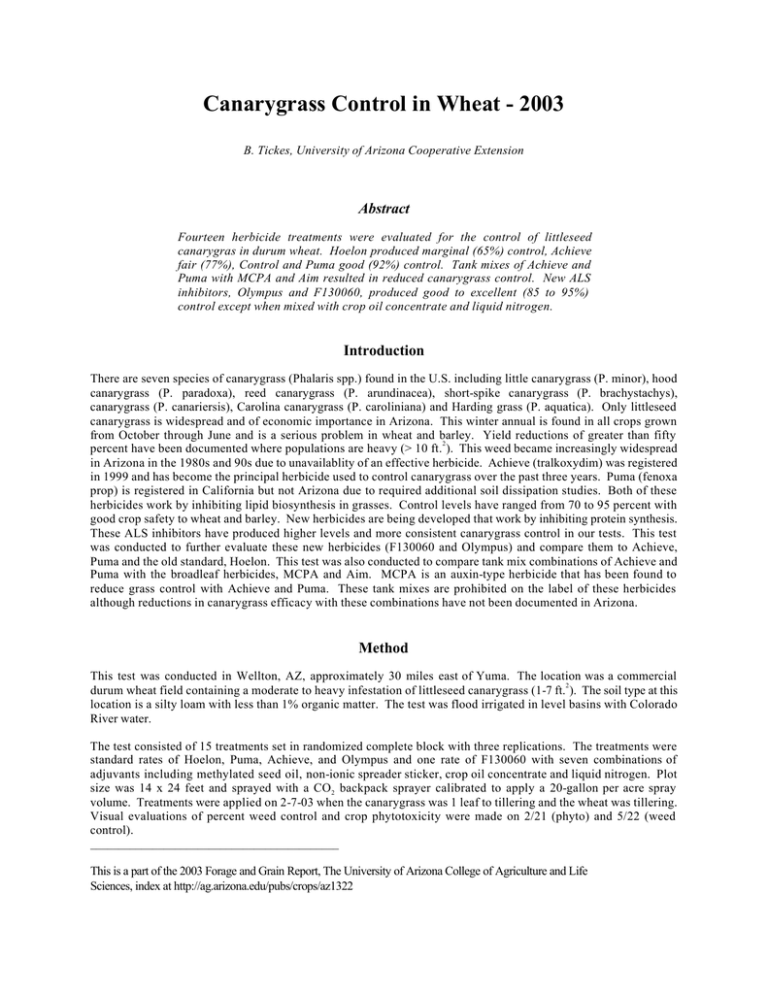
Canarygrass Control in Wheat - 2003 B. Tickes, University of Arizona Cooperative Extension Abstract Fourteen herbicide treatments were evaluated for the control of littleseed canarygras in durum wheat. Hoelon produced marginal (65%) control, Achieve fair (77%), Control and Puma good (92%) control. Tank mixes of Achieve and Puma with MCPA and Aim resulted in reduced canarygrass control. New ALS inhibitors, Olympus and F130060, produced good to excellent (85 to 95%) control except when mixed with crop oil concentrate and liquid nitrogen. Introduction There are seven species of canarygrass (Phalaris spp.) found in the U.S. including little canarygrass (P. minor), hood canarygrass (P. paradoxa), reed canarygrass (P. arundinacea), short-spike canarygrass (P. brachystachys), canarygrass (P. canariersis), Carolina canarygrass (P. caroliniana) and Harding grass (P. aquatica). Only littleseed canarygrass is widespread and of economic importance in Arizona. This winter annual is found in all crops grown from October through June and is a serious problem in wheat and barley. Yield reductions of greater than fifty 2 percent have been documented where populations are heavy (> 10 ft. ). This weed became increasingly widespread in Arizona in the 1980s and 90s due to unavailablity of an effective herbicide. Achieve (tralkoxydim) was registered in 1999 and has become the principal herbicide used to control canarygrass over the past three years. Puma (fenoxa prop) is registered in California but not Arizona due to required additional soil dissipation studies. Both of these herbicides work by inhibiting lipid biosynthesis in grasses. Control levels have ranged from 70 to 95 percent with good crop safety to wheat and barley. New herbicides are being developed that work by inhibiting protein synthesis. These ALS inhibitors have produced higher levels and more consistent canarygrass control in our tests. This test was conducted to further evaluate these new herbicides (F130060 and Olympus) and compare them to Achieve, Puma and the old standard, Hoelon. This test was also conducted to compare tank mix combinations of Achieve and Puma with the broadleaf herbicides, MCPA and Aim. MCPA is an auxin-type herbicide that has been found to reduce grass control with Achieve and Puma. These tank mixes are prohibited on the label of these herbicides although reductions in canarygrass efficacy with these combinations have not been documented in Arizona. Method This test was conducted in Wellton, AZ, approximately 30 miles east of Yuma. The location was a commercial 2 durum wheat field containing a moderate to heavy infestation of littleseed canarygrass (1-7 ft. ). The soil type at this location is a silty loam with less than 1% organic matter. The test was flood irrigated in level basins with Colorado River water. The test consisted of 15 treatments set in randomized complete block with three replications. The treatments were standard rates of Hoelon, Puma, Achieve, and Olympus and one rate of F130060 with seven combinations of adjuvants including methylated seed oil, non-ionic spreader sticker, crop oil concentrate and liquid nitrogen. Plot size was 14 x 24 feet and sprayed with a CO2 backpack sprayer calibrated to apply a 20-gallon per acre spray volume. Treatments were applied on 2-7-03 when the canarygrass was 1 leaf to tillering and the wheat was tillering. Visual evaluations of percent weed control and crop phytotoxicity were made on 2/21 (phyto) and 5/22 (weed control). ____________________________________________ This is a part of the 2003 Forage and Grain Report, The University of Arizona College of Agriculture and Life Sciences, index at http://ag.arizona.edu/pubs/crops/az1322 Results Results (Table 1) indicated that Hoelon was marginal (65%), Achieve fair (77%), and Puma good (92%) in controlling canarygrass under the conditions present in this test. When mixed with MCPA and Aim, the weed control with Puma and Achieve were reduced significantly. The ALS inhibitors, Olympus and F130060 produced very good canarygrass control (85 to 95%) except when mixed with crop oil concentrate and liquid nitrogen (73%). The WG14 formulation of F130060 also produced inferior control (63%) crop safety was good with all treatments except Olympus which resulted in stunting of 20 to 25% and the Aim plus Achieve tank mix which only temporarily burned the leaves but did not hurt new growth appearing after treatment. Yields were not taken due to heavy lodging across the plots. Acknowledgements This project was supported by the Arizona Grain Research and Promotion Council and Bayer Cropscience and conducted with Marvin Marlett. Table 1. Control of Littleseed Canarygrass with 14 Herbicide Treatments Herbicide Rate (acre) Surfactant Rate (acre) Control (%) Avg Phyto (%) Avg Hoelon 2.6 pts. - - 65 d 0c Achieve 0.6 lb. Supercharge 0.5% 77 bc 0c Puma 0.6 pt. - - 92 ab 0c Olympus 0.05 lb. NIS 0.25% 95 a 23 a Puma & MCPA Achieve & MCPA Achieve + AIM F130060 0.6 pt. + 2 pts. 0.6 lb. + 2 pts. 0.6 lb. + 0.3 oz 10G/HA - - 50 f 0c Supercharge 0.5% 50 f 0c Supercharge 0.5% 53 f 20 b 0c 10G/HA 93 ab 0c F130060 10G/HA F107892 + NIS 88 ab 0c F130060 10G/HA F107892 + NIS + UAN 93 ab 0c F130060 10G/HA 85 bc 0c F130060 10G/HA F107892 + COC F107892 + COC + UAN 73 d 0c F130060 (WG14) UTC 30G/HA MSO + UAN 63 e 0c - - 20G/HA 24 oz 20G/HA + 24 oz + 64 oz 20G/HA + 0.25% 20G/HA + 0.25% + 64 oz 20G/HA + 0.25% 20G/HA + 24 oz + 64 oz 24 oz + 64 oz - 90 ab F130060 F107892 + MSO F107892 + MSO + UAN 0g 0c LSD(0.05)=8.95 LSD(0.05)=1.73
